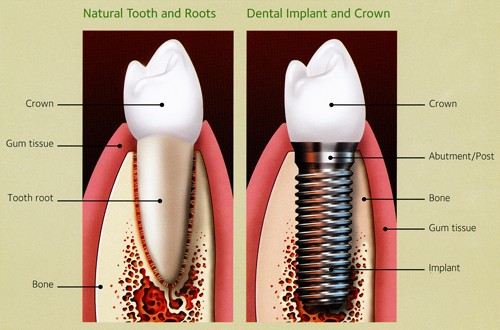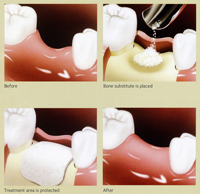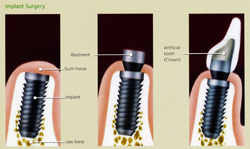Implants: The New Standard of Care for Tooth Replacement
Dr. Werts and Dr. Yang avidly pursue surgical training to keep abreast of the rapid changes in the field of implant dentistry. Here Dr. Werts is being interviewed by one of his mentors, Dr. Ziv Simon.
Watching this video will help you better understand the factors influencing the wide variability of implant costs.
An option for replacing teeth and stabilizing dentures

If you have been unfortunate enough to lose one or more teeth, or if you are a denture wearer, you now have an alternative to replace teeth with dental implants. Until recently bridges and dentures have been the replacement alternative for missing teeth. Dentistry can now predictably offer you dental implants which are as close as we have ever been to give you back the teeth you have lost. Dental implants give you the comfort in mimicking the solid feel of “real” teeth, and/or the anchorage for the loose dentures you may have been suffering with.
What is an Implant?

Dental implants are man-made machined titanium anchors that are the artificial replacement for natural tooth roots. Their history of increasing use dates back to the 1980’s and they have proven themselves to the point that they are now the standard of care. These cylindrical anchors fuse, or “integrate” into the jaw bones to become stable bases for one or more custom replacement teeth. With denture applications attachments are connected into the implants which have fasteners to which dentures can snap into, anchoring the floating prostheses so many people have had to cope with. Dental implants can offer you normal chewing function closer than we have ever been able to offer before.
The Process of Implant restoration

The first phase is diagnostic. We must determine what we have to work with and what the desired end result will be. This is achieved through impressions and casts of the existing dental condition. A diagnostic “wax up” of the desired result is made. From here a radiographic stent is fabricated so that a computerized xray, Cone Beam Technology, can demonstrate how much bone is available in the sites we wish to place the implants and the proximity of any nerves or anatomical variations. If there is insufficient bone available, bone grafting procedures are now routinely performed to increase the volume of bone present. From this the decision which implants to use and their virtual placement can be designed and practiced for the highest chance of success.
The surgical phase. After appropriate anesthesia, the dentist prepares the implant recipient site(s) in the jaw bone. The implant is place either at or just above the top of the bone. A cover screw is placed and this will be worn through the healing phase which usually runs three to six months while the implant(s) become fused to the bone, a process called “osseointegration.” In general , there will be some swelling and/or tenderness in the surgical site and appropriate pain medications will be prescribed. Moderation in temperature and density of foods is recommended to assist in healing.
The restorative Phase.

In some cases the healing cover screw is intentionally submerged under the gum tissue and it must be uncovered at a separate minor surgical step. Other times, the cover screw remains extended through the gum and needs only to be removed. Impressions of the teeth and implant are taken and sent to the dental laboratory. The middle connecting component of implant restorations is called an “abutment.” Every case is different and these can be in the form of one piece combined with the crown, or a separate machine milled part, or a custom designed cast gold or titanium component that follows the curvature of the gum line. It is on the abutment that the crown is place mimicking the tooth/teeth that were lost. For denture retention the abutment is the component that contains the fastener into which the denture will snap.
Are you a candidate for dental implants?
If you are in good health, have adequate bony support or enough foundation to increase what is available, you are a candidate. However, you must be committed to proper oral hygiene. A dental implant can be lost the same way a tooth can be lost through insufficient care. Final decisions that you are indeed a candidate can only be made through a thorough examination, diagnosis, and consultation with your dentist.
Denture stabilization with Mini Dental Implants
For more information how these small diameter implants could improve your experience with dentures and quality of life, click here.
